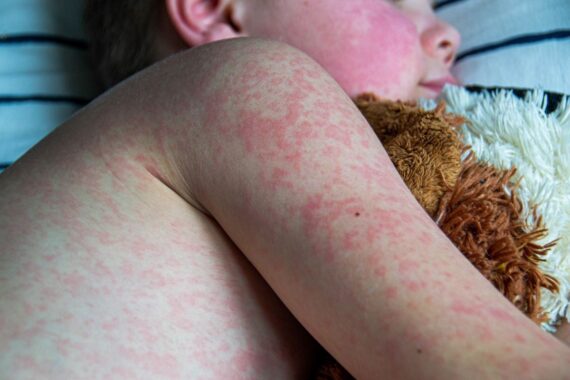GP specialist in paediatrics Dr David Capehorn explains how to explore the differentials and course of action in a child who has developed a rash after a recent course of amoxicillin
You see a two-year-old child with a widespread blanching erythematous macular rash which appeared the previous day. The background is that he saw a locum five days previously with a fever, sore throat and cough, and was started on a course of amoxicillin. He seems well in himself and examination reveals nothing other than the rash. While you are pondering on whether this is a viral rash or a penicillin allergy, the child’s mum mentions that she is 10 weeks pregnant.
1. If this is an infectious rash rather than an allergy, what diagnoses should the GP consider? And how should the fact that the mother is pregnant affect the management?
Most common viral rashes in children are associated with febrile illnesses, and these rashes typically appear as the fever subsides or later in the illness and so the differential is relatively wide here.
Given the child’s presentation, viral exanthems are a key differential, including:
- Roseola infantum (HHV-6): Roseola begins with a sudden high fever (often exceeding 39°C) lasting 3-5 days, with the child (typically between 6 months and 2 years old) appearing well otherwise. The fever resolves abruptly, followed by the appearance of a maculopapular rash, typically starting on the trunk and spreading to the face, neck and limbs. The rash is blanching, non-pruritic, and may last a few hours to a couple of days.
- Measles: The measles prodrome includes fever, cough, conjunctivitis and coryza (the ‘3 Cs’). The characteristic rash begins 2-4 days after the onset of symptoms, starting at the hairline and spreading from the face down to the trunk and extremities. The rash is maculopapular, erythematous and initially blanching but may become confluent as it progresses. Koplik spots, small white lesions on the buccal mucosa, may be a distinguishing feature seen before the rash.
- Rubella: This is generally a milder illness than measles, with a low-grade fever and lymphadenopathy, particularly postauricular, occipital and cervical nodes. The maculopapular rash begins on the face and rapidly spreads to the rest of the body, lasting about 3 days. Rubella can be differentiated by the more subtle nature of the rash and the absence of the severe respiratory symptoms seen in measles.
- Parvovirus B19 (Erythema infectiosum): Parvovirus B19 starts with mild nonspecific symptoms such as fever, headache and malaise. After these early symptoms resolve, the characteristic ‘slapped cheek’ facial rash appears, followed by a reticular or lacy rash on the trunk and limbs. The rash can be exacerbated by heat or sunlight and may recur intermittently over weeks. In pregnancy, this virus can cause significant complications such as fetal anaemia and hydrops fetalis.
- Enteroviruses and adenoviruses: These can present with a variety of rashes alongside non-specific systemic symptoms. Adenovirus infections primarily cause respiratory and conjunctival symptoms, but can present with a nonspecific maculopapular rash. The rash typically appears with the febrile illness and is diffuse, non-pruritic and erythematous. Adenovirus-associated rash is often seen accompanied by pharyngitis, conjunctivitis and fever. Enteroviruses, including coxsackieviruses and echoviruses, are common causes of childhood exanthems. The hallmark rash in enteroviral infections is hand, foot and mouth disease (HFMD), characterized by vesicular lesions on the palms, soles and oral mucosa. However, in addition to HFMD, enteroviruses can cause herpangina (vesicular exanthem on the soft palate and tonsillar pillars) or a diffuse, erythematous maculopapular rash, particularly in summer and autumn outbreaks.
Implications for the pregnant mother:
The fact that the mother is 10 weeks pregnant significantly alters the management, as certain viral infections can pose teratogenic risks. Rubella and parvovirus B19 are of particular concern.
- Rubella: Congenital rubella syndrome (CRS) can lead to serious fetal anomalies if contracted in early pregnancy. Maternal immunity to rubella should be confirmed and, if the mother is non-immune, she must be advised regarding the risks of infection (see Box below).
- Parvovirus B19: Infection during pregnancy can lead to fetal anaemia, hydrops fetalis, and even fetal loss. Maternal serology for parvovirus B19 should be obtained if this is suspected, and close monitoring of the pregnancy is warranted if the mother is infected.
Steps to check mother’s rubella immunity status
- Review vaccination history: The GP should first ask about the mother’s history of vaccination, specifically whether she received the Measles, Mumps, and Rubella (MMR) vaccine. Two doses of the MMR vaccine usually confer lifelong immunity to rubella. If no documented history or uncertainty about previous vaccinations, further testing is necessary.
- Serological testing: The GP would order a blood test to check for rubella immunity. The key marker is the presence of rubella-specific IgG antibodies. Positive rubella IgG antibodies indicates past infection or successful vaccination, confirming immunity.
- Assessment of rubella IgM (if recently exposed): If the mother was recently exposed to rubella, the GP may also check for rubella IgM antibodies, which indicate recent infection. Positive rubella IgM antibodies suggests a current or very recent rubella infection, which requires immediate medical evaluation to assess fetal risk. Negative rubella IgM antibodies suggests no recent infection.
- Counselling: If immune, the mother is reassured, and no further action regarding rubella is needed. If non-immune, advise the mother on the risks of rubella exposure during pregnancy and stress the importance of avoiding contact with individuals infected with rubella. Also offer the MMR vaccine post-pregnancy (since the live vaccine cannot be given during pregnancy).
2. Are there clinical pointers in terms of timing, appearance of rash or other features that can help the GP distinguish a viral rash from an allergy in this situation?
In this scenario, the primary challenge is distinguishing between a viral exanthem and a possible penicillin (amoxicillin) allergy, particularly non-IgE-mediated allergy.
Three factors can be considered: (i) timing of the rash; (ii) appearance of the rash; (iii) other systemic features.
(i) Timing of the rash:
- Viral exanthems: Viral rashes often develop concurrently with or slightly after systemic symptoms such as fever and upper respiratory signs, consistent with the child’s initial presentation. The appearance of the rash after several days of fever is characteristic of viral illnesses, especially roseola.
- Non-IgE-mediated drug reaction: Amoxicillin-related delayed hypersensitivity reactions usually manifest 4-10 days after drug initiation, aligning with the timeline in this case. These delayed hypersensitivity reactions (type IV) to penicillin are typically non-life-threatening and often manifest as a maculopapular rash that may develop several days after starting the antibiotic. These rashes are generally benign, self-limiting and not associated with severe systemic symptoms like anaphylaxis. Thus, a misdiagnosis of viral illness over a delayed hypersensitivity reaction may not have serious immediate consequences, as both conditions are often managed conservatively with supportive care.
(ii) Appearance of the rash:
- Viral exanthems: Viral rashes, including those caused by roseola, measles, or rubella, are generally blanching, erythematous and maculopapular in nature. They may start on the trunk and spread centrifugally.
- Allergic rash: Drug-induced maculopapular rashes are often more diffuse and uniform. They can be itchy but typically lack the systemic symptoms seen in viral infections.
(iii) Other features:
- Systemic symptoms: Viral rashes are commonly associated with fever, cough, coryza, and malaise, whereas drug rashes, particularly non-IgE-mediated types, are less likely to present with fever.
Overall, the child’s well appearance, the timing of the rash following systemic viral symptoms, and the lack of pruritus or other allergic symptoms all point towards a viral exanthem rather than a penicillin allergy.
3. If in doubt, would you opt for labelling the child in this scenario as allergic to penicillin? Are there any circumstances where it would be important to ‘prove’ this and if so how would we go about it?
It is important to avoid prematurely labelling children as allergic to penicillin. Up to 90-95% of those labelled are not truly allergic. Mislabelling can lead to avoidance of first-line antibiotics like penicillin, which may result in the overuse of broader-spectrum antibiotics.
Type IV hypersensitivity reactions, which are T-cell mediated, typically start to manifest 48 to 72 hours after exposure to the drug. These delayed drug reactions are generally mild and self-limiting, in contrast to IgE-mediated (Type I) hypersensitivity reactions, which can lead to anaphylaxis on re-exposure. While Type I reactions require more urgent management, non-IgE-mediated reactions tend to be less severe and pose a low risk of severe allergic reactions in the future.
Delayed maculopapular rashes, which are a common form of non-IgE-mediated drug reaction, rarely progress to severe cutaneous adverse reactions (SCARs) such as Stevens-Johnson Syndrome (SJS) or Toxic Epidermal Necrolysis (TEN). The incidence of SJS or TEN related to penicillin exposure is exceedingly rare, estimated at 1-2 cases per million drug exposures.
Risk of recurrence with re-exposure
In suspected non-IgE-mediated drug reactions, the risk of more severe reactions upon re-exposure to penicillin is low. The majority of children are likely to tolerate penicillin again, though cautious re-exposure is advised, possibly through supervised oral challenges (requiring secondary care referral). The likelihood of a more severe reaction on re-administration of penicillin is minimal. Retrospective studies indicate that 60-80% of patients with a history of mild non-immediate reactions experience recurrence when re-challenged with penicillin. However, in most cases, the severity of the reaction mirrors the initial event, so the overall risk remains small.
Cross-reactivity between penicillins and beta-lactams
Delayed hypersensitivity to penicillin does not necessarily imply cross-reactivity with all beta-lactam antibiotics. Patients who develop delayed maculopapular rashes with one penicillin often do not experience the same reaction when exposed to other beta-lactams, such as cephalosporins. This reduces the concern for severe reactions when treating with different beta-lactam antibiotics in the future.
Outgrowing penicillin allergy
Many patients, particularly children, may outgrow their penicillin allergy over time. Studies suggest that up to 80% of individuals initially labelled as penicillin-allergic, even those with documented non-IgE-mediated reactions, do not react to the drug after 10 years. This underscores the importance of critically re-evaluating historical allergy status, by reviewing the records carefully, as many children no longer exhibit hypersensitivity (for example, some children may have been given penicillin subsequent to the index event without adverse reaction).
Confirming penicillin allergy
In most cases, formal testing is not necessary. In cases where it is clinically important to confirm or rule out penicillin allergy, for example where there is a history of severe or life-threatening reactions (eg, anaphylaxis, SJS, or TEN) – allergy testing is warranted. Skin testing is useful for detecting IgE-mediated penicillin allergies, but it is not effective for delayed, non-IgE-mediated reactions. In cases where skin testing is negative or inconclusive for delayed reactions, the gold standard for diagnosis is a controlled oral challenge to confirm or exclude true penicillin allergy. This would necessitate a referral to secondary care.
Dr David Capehorn is a GPwSI in paediatrics, founder and former clinical director of the Paediatric GPSI Primary Care Paediatric Service in Bristol, and honorary associate specialist at Bristol Children’s Hospital Emergency Department.














where does the interaction between the drug and the virus make a delayed hypersensitivity a confusing term ? It used to be said that this rash was hugely more likely with EB infections? Is this still the case or a myth? as this rash seems much commoner after amoxil can pen v be used safely if there is a strep outbreak concern